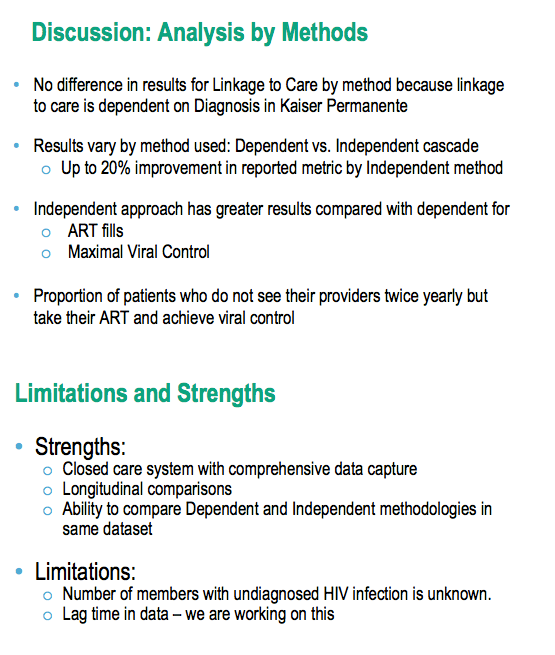 |
 |
 |
| |
The HIV Care Cascade ("Cascade") Measured Over Multiple Time Periods Varies by Time Period and Method
|
| |
| |
Reported by Jules Levin
20th International AIDS Conference, July 20-25, 2014, Melbourne
Michael Horberg1,2, Leo Hurley3,4, Daniel Klein5, William Towner6, Peter Kadlecik7, Colleen Finnegan8, Miguel Mogyoros9, RJ Matyas10, Philip Brachman11, Michael Silverberg3,4
1Mid-Atlantic Permanente Research Institute of Kaiser Permanente Mid-Atlantic States, Rockville, MD, US;
2HIV Initiative of Kaiser Permanente, Rockville, MD, US;
3HIV Initiative of Kaiser Permanente, Oakland, CA, US;
4Kaiser Permanente Northern California Division of Research, Oakland, CA, US;
5 Kaiser Permanente Northern California, San Leandro, CA, USA;
6 Kaiser Permanente Southern California, Los Angeles, CA, US;
7 Kaiser Permanente Mid-Atlantic States, Washington, DC, US;
8Kaiser Permanente Northwest, Portland, OR, US;
9Kaiser Permanente Colorado, Denver, CO, US;
10Kaiser Permanente Hawaii, Honolulu, HI, US;
11Kaiser Permanente Georgia, Atlanta, GA, US

-----------------------
Program abstract
Background: The HIV care cascade can evaluate programmatic success over time. Typically, the cascade requires that subsequent stages of care be dependent on the success of prior stages, which may underestimate actual success. Another approach is to have subsequent stages independent of prior stages. We examined these two approaches in Kaiser Permanente, which provides comprehensive HIV care in eight US states and Washington, DC.
Methods: We created cascades for all HIV+ members ≥13 years old with ≥8 months membership for 2010-2012. We measured "linkage" to care (a visit/CD4 within 90 days of being identified HIV+ for new patients; ≥1 medical visit in year for established patients); "retention" in care (≥2 medical visits ≥60 days apart); filled ART (filled ≥3 months of combination ART); and viral suppression (HIV RNA< 200 copies/mL last measured in year). We prepared the cascades as "dependent" (later stage success requiring prior stage success), and "independent" (each stage derived independently of prior stages). Thus, for the independent cascade, results can increase or decrease at later stages, while with dependent cascade only decrease.
Results: Charts show the cascades under dependent (A) and independent assumptions (B). As retention requires diagnosis and linkage, those three metrics are inherently dependent.
-------------------






|
| |
|
 |
 |
|
|